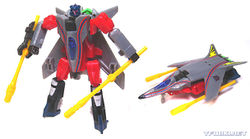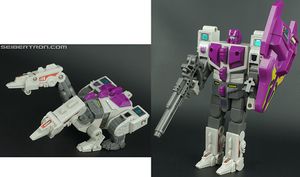Articulation
From Transformers Wiki

Articulation commonly describes the number, position, and type of a Transformers toy's joints. "Posability" is a neologism often found in conjunction with mentions of articulation, although they are not necessarily interchangeable (see articulation vs. posability).
Contents |
How to make toys well articulated
The more joints on a figure (in either form), the more articulated it is. This generally includes the shoulders, elbows, hips and knees, and sometimes even wrists, ankles, and neck among others. Posability in Transformers ranges from the Spychangers, who are limited to rotating their arms up and down (shoulder swivel articulation only), to the non-transforming Revoltech line, the entire selling point of which is the high amount of articulation per figure. Possibly the only Transformer toys that have no real articulation but can still be said to transform are the Battlechargers, the Throttlebots, the Duocons, Under-3, and arguably Freedom Fighter and Enemy.
Articulation is one of many factors that fans weigh when evaluating a toy, and naturally is of subjective value. To some, if a toy has unusually good posability, they will buy it over another figure that looks "better", but can not move as much. Toys with very few points of articulation are often referred to as bricks. Beginning with the Beast Era, ball joints became more common, lending toys a higher level of posability.
Unfortunately, there is a trade-off between articulation and production cost — the more complex the figure, the more parts that must be assembled and therefore produced, and the higher the retail price. For example, Armada Megatron could easily have been given knees, but instead has a plethora of other gimmicks. Many customizers have taken to altering the figure to be more posable, and while some fans claim this is how Hasbro "should" have made the original, doing so would likely have sent the figure over budget.
Some figures are hampered in how well they can pose by their transformation or alternate mode. Armada Hot Shot's shoulders, for example, are limited by how he transforms. A different transformation may have allowed his arms to move on an additional axis... however, as noted above, this would have also increased the toy's complexity and cost. Even when the needed articulation is present, posability can also be limited by kibble blocking a part's motion.
Conversely, sometimes a toy's posability is improved by its transformation. Or, perhaps more accurately, the designers managed to place the transformation-related articulation in places that would also serve the robot mode's articulation. The Unicron toy released during Armada is an example of this. His neck, shoulders, arms, wrists, hips, ankles, and feet must all be moved to change him from planet to robot and back.
Articulation can have a drawback. If a figure is overloaded with joints, especially in the legs and waist, this can result in the figure having problems supporting its own weight, holding a pose, or even standing. This is a common complaint with Omega Prime. He is loaded with exciting and dramatic articulation, but is so top-heavy that it is hard to get him to do anything beyond "standing up straight". The much-loved ball joints are especially susceptible to weight and play wear problems, and as such are generally not used on larger figures. A similar level of flexibility can be created with a combination of two swivels or ratcheted swivels.
Articulation as a feature
For most of the Generation 1 era, articulation tended to be on the low side. Due to the relatively primitive engineering of the era, most toys featured what was necessary for their transformation and nothing more, which resulted in levels of articulation being highly inconsistent. Compare, for instance, Soundwave (useful movement at the neck, shoulders, elbows, and hips) to Megatron (basically just the shoulders). Many toys had just enough mobility to point their weapons forward.
In the mid 90s, Hasbro began introducing highly articulated toys and promoting their posability as a gimmick and selling point. In 1994, the Generation 2 Laser Rod cards advertised the toys as "Super Poseable!", and the Dreadwing and Smokescreen box described the toys as "Super Poseable Robots". Laser Optimus Prime's box notes the toy's "Fully poseable Laser Optimus Prime robot" mode. Other highly posable toys from the G2 era include the Cyberjets. Beast Wars (1996) was the first Transformers line to make a high degree of articulation standard across the toyline.
Moving into the 2010's and early 2020's, Hasbro continues to make increasing articulation a selling point as engineering improves and the collectors' market grows. By the time of the War for Cybertron Trilogy and Studio Series toylines, articulation points such as waist rotation, ankle tilts, and wrist swivels have become commonplace even among smaller characters such as Warpath and Cliffjumper.
Posable figures and safety

Unlike what most people think, an articulated action figure passes the safety regulations better than a brick. During the time Hasbro started to make its own molds to represent characters as toys instead of importing from other toy lines, the company noticed that safety standards required a toy to withstand a pulling force of 20 pounds to deem them safe. Because most toys in those days had little to no outward movement in their legs or arms, they would rather quickly break with little force, so most figures were made with fused legs, preventing kids from pulling the legs apart. Because of this, most of the toys dropped articulation to make the figures stronger, turning a large amount of them into "bricks". During the time Takio Ejima started working on the brand, he noted that they could make the toys safer by the use of ball joints, making it easier for the toy to pass the test (ball joints simply pop off under stress and can subsequently be snapped back on, resulting in no breakage and thus no safety hazard), and have a full range of motion at the same time. This idea would even change the standard of articulation outside the Transformers brand.
Articulation vs. posability
Official Hasbro sources have used the neologism posability (also spelled poseability) and the adjective form poseable at least as early as 1994 to describe highly articulated figures.[1] The fandom often uses the term posability interchangeably with articulation; where a distinction is drawn, articulation refers to the number of joints and range of motion, while posability refers to a figure's ability to assume and hold poses (for instance, for display purposes). To illustrate the difference, Beast Machines Mega Cheetor has high articulation but poor posability due to its difficulty standing up and its arm gimmick.
See also
References
- ↑ Underwood, Bill. "Go Joe! // Doll Celebrates 30th Birthday". Tulsa World, 29 June 1994.


